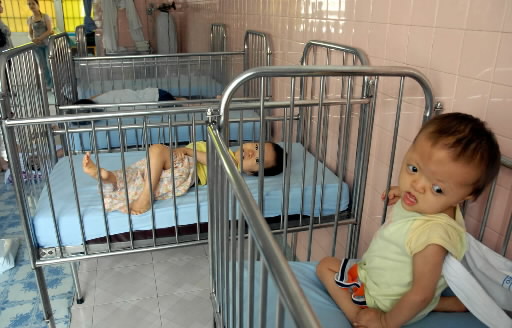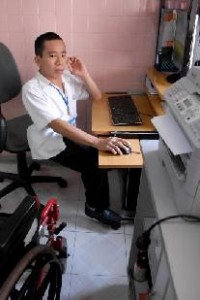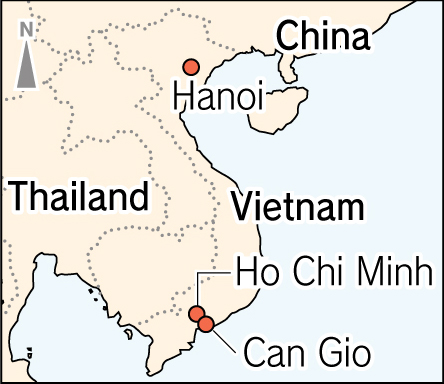Vietnam: 50 years after the use of defoliants, Part 1: Walking the affected areas, Article 3
Jul. 6, 2012
Article 3: Peace Village Children
Short lives spent in bed
by Takamasa Kyoren, Staff Writer
Duc: “It’s my turn to offer support”
Metal beds lined the walls at the Lang Hoa Binh (Peace Village) in Ho Chi Minh City in southern Vietnam. Located at Tu Du Hospital, the largest obstetrics hospital in Vietnam, the facility provides support for people suffering from the effects of defoliants. Most of its sixty patients are second- and third-generation sufferers who range in age from infants to 18 years old. They undergo medical treatment and rehabilitation at the facility.
“The children in this room haven’t been outside since they came here,” a nurse said as she paused while preparing their lunches. Many of the seriously disabled children come from poor families and were simply left there by parents who then disappeared.
There are seven or eight beds in each room. A form at the entrance to each room lists the names and birthplaces of each patient and describes their symptoms such as “missing both legs” or “anophthalmia,” a congenital absence of eyes. Pham Thi Phuong Khanh, 16, who suffers from hydrocephaly, lay on her bed with a tube in her nose and stared at the ceiling. She was born in the Can Gio area on the outskirts of the city, which was heavily sprayed with defoliants by the U.S. military during the war.
“The children who can undergo rehabilitation are better off. Some of the children die young after being bedridden all their lives,” said Dr. Le Thi Hien Nhi, 44, deputy chief of the hospital’s Rehabilitation Department.
The Peace Village was built in 1990 with the assistance of a German foundation. There are now eight Peace Villages in Vietnam. Children are admitted to the facilities through hospitals or through local branches of the Vietnam Association for Victims of Agent Orange/Dioxin (VAVA), and there is always a waiting list. The villages are operated with funds from the hospital and donations from people in Vietnam and overseas.
Continued high rate of disabilities
About 50,000 babies are born every year at Tu Du Hospital. Of these about 1 percent suffer from serious physical disabilities such as cleft palate or hydrocephaly. The rate has gone down slightly from the 1980s when it was between 1.0 and 1.6 percent, but it remains higher than the pre-war 1950s rate of 0.3 percent. There are also many stillbirths and miscarriages as a result of disabilities.
In a reference room at the end of a hall were about 200 jars containing fetuses preserved in formalin. With the rapid increase in the number of babies born with abnormalities in the 1960s, fetuses were saved in order to investigate the causes. This effort was led by Dr. Nguyen Thi Ngoc Phuong, 68, former director of the hospital, who was then a trainee doctor. Some of the fetuses are from the 2000s. Fetuses without brains and twins attached at the chest tell of the tragedy of the use of defoliants.
Nguyen Duc, 31, was at work at the Peace Village. Mr. Nguyen was born attached to his twin brother Viet at the lower body. They were surgically separated at Tu Du Hospital in 1988. A movement was launched in Japan to provide support for their surgery. (Viet died in 2007.) “Now it’s my turn to support the victims,” said Mr. Nguyen. In addition to working in the facility’s offices, he also goes out to raise funds and give lectures.
In April of last year Mr. Nguyen visited an elementary school in Shiga Prefecture. At that time he saw a cherry tree that had been propagated from a tree in Hiroshima that survived the A-bombing. The tree had been sent to the school from a junior-senior high school in Hiroshima. “Viet and I are symbols of the war,” he said. “Now I would like to be a testament to recovery and peace like that cherry tree.”
Symptoms develop after returning home
There is also a Peace Village in the former North Vietnam, where defoliants were not sprayed, because many soldiers developed cancer and skin diseases after returning from the war, and many babies were born with abnormalities.
About 100 people live in the Peace Village in Hanoi. In an occupational therapy room a boy whose spine and legs were bent was working at a loom that was given to the facility by a private organization in Japan. “I would like him to somehow live by his own ability,” said Nguyen Thu Ha, 41, vice director of the Peace Village with tears in his eyes. But the reality is quite different.
(Originally published on June 21, 2012)










